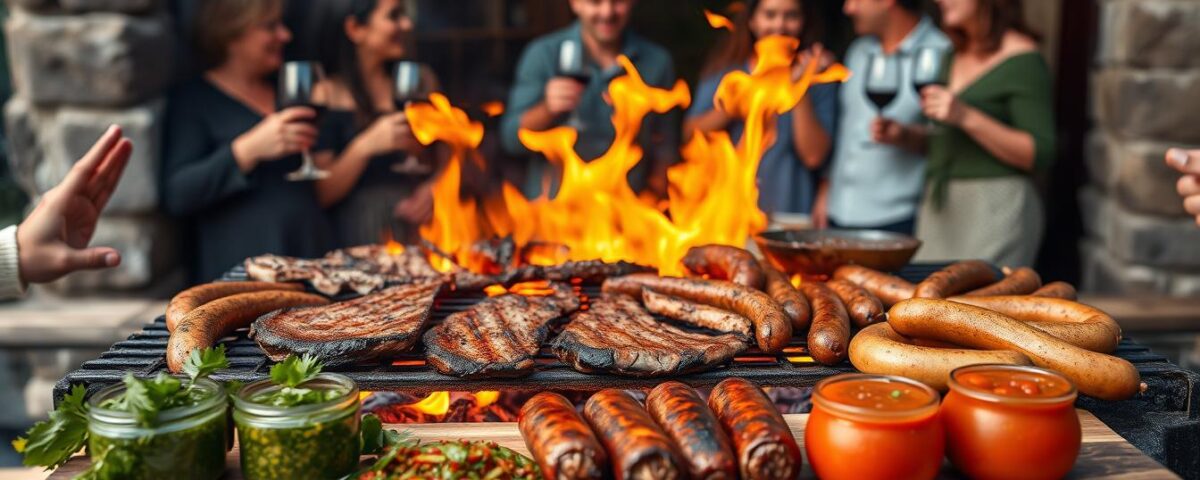
Why You’ll Fall in Love with Lebanese Food (And How to Start Cooking It)
April 28, 2025
How to Make Real Russian Pelmeni – A Cozy Winter Classic
April 28, 2025I still remember the first time I tasted authentic asado—the smoky aroma, the crackle of glowing embers, and the laughter of friends gathered around the grill. It wasn’t just a meal; it felt like a warm embrace from a culture that celebrates connection. That moment sparked a decade-long journey of learning, mistakes, and triumphs that transformed my backyard into a space where tradition and flavor collide.
Early on, I burned more steaks than I care to admit. But through countless gatherings—from cozy family Sundays to lively summer fiestas—I discovered that mastering fire and meat isn’t about perfection. It’s about patience, respect for the process, and sharing stories while the coals glow. What started as a curiosity became a ritual that connects me to Argentina’s vibrant grilling heritage, even in my suburban kitchen.
In this guide, I’ll show you how to recreate that magic without needing a sprawling ranch or decades of experience. You’ll learn how to choose cuts that sing with flavor, control heat like a seasoned pro, and turn every cookout into an unforgettable experience. Let’s turn your grill into a gateway to South American soul.
Key Takeaways
- Asado is a cultural experience blending food, fire, and community
- Proper fire management separates good results from exceptional ones
- Quality meat selection matters more than complex seasonings
- Traditional techniques adapt beautifully to home grilling setups
- The journey from novice to confident host takes practice, not perfection
- Every gathering becomes richer when you embrace the ritual’s rhythm
Embracing the Tradition: An Introduction to Argentine Asado Culture
Imagine a Sunday where time slows down, and the main event is the crackle of wood meeting flame. This is the heartbeat of Argentina’s grilling tradition—a social ritual where meals stretch for hours and every cut tells a story.
What makes this practice special isn’t just the cooking method, but how it binds communities. Families gather around the grill as casually as others might around a dinner table, with conversations flowing as steadily as the smoke.
The choice of wood shapes everything. Hardwoods like quebracho or algarrobo burn slowly, creating steady heat that coaxes flavor from meat without rushing. I learned this through trial and error—using the wrong wood once left my short ribs tasting like campfire leftovers.
| Wood Type | Burn Time | Best For |
|---|---|---|
| Quebracho | 4-5 hours | Beef ribs |
| Algarrobo | 3-4 hours | Chorizo |
| Mesquite | 2-3 hours | Chicken |
Understanding cuts became my gateway to authenticity. Unlike quick-grill steaks, traditional choices like flank or skirt need low heat and attention. They’re not just meals—they’re lessons in patience.
Time here isn’t measured in minutes, but in shared laughter and glowing embers. The magic happens when you stop watching the clock and start listening to the sizzle. That’s when you realize this isn’t about food—it’s about keeping stories alive through fire.
Tools of the Trade: Essential Equipment and Grill Setup
When I first tried grilling like they do in South America, I nearly ruined dinner by using flimsy tools. That’s when I learned the right gear makes every step matter—from arranging coals to serving perfect steak.
Understanding the Parrilla and Its Adjustability
A cast-iron parrilla changed my game. Unlike standard grills, its adjustable height lets you control heat intensity. Lower it for quick searing, raise it for slow cooking. This flexibility helps premium beef cuts develop that signature crust without drying out.
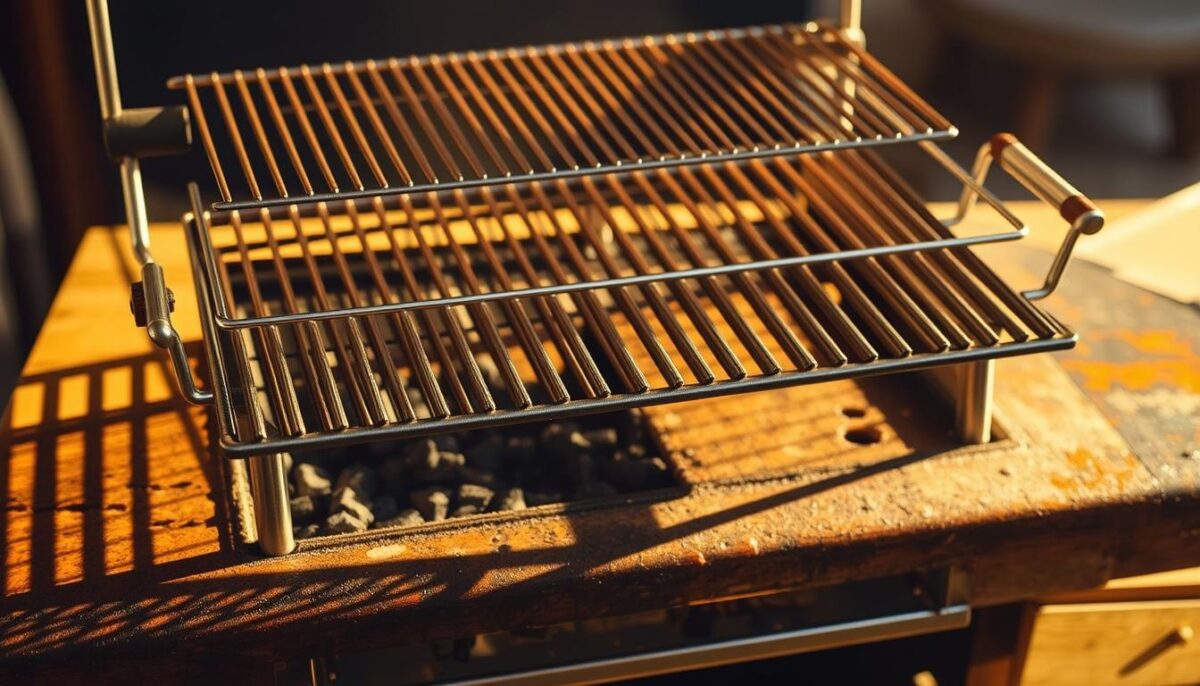
Must-Have Asado Tools: Shovel, Rake, and More
Three tools live by my grill:
| Tool | Purpose | Pro Tip |
|---|---|---|
| Long-Handled Shovel | Moves hot coals safely | Keep a water bucket nearby |
| Metal Rake | Levels ember beds | Create zones for different meats |
| Sturdy Tongs | Flips meat gently | Never pierce the surface |
Quality matters most when choosing steak. Look for marbled ribeyes or flank cuts with visible fat stripes. These handle slow heat beautifully, absorbing smoky flavors while staying juicy.
Setting up your station takes practice. Arrange tools within reach, position the parrilla over glowing coals, and remember—patience turns good equipment into great results. The sizzle tells you when it’s time to act.
Ignite the Flame: Starting Your Fire with Wood and Charcoal
Mastering the flame transformed my grilling from mediocre to memorable. The foundation of every great cookout lies in how you build your fire—it’s equal parts science and intuition.
Choosing the Right Wood, Coals, and Pine Cones
Dry hardwoods like oak or hickory became my secret weapons. They burn cleaner than briquettes and infuse meat with subtle sweetness. For quick ignition, I layer pine cones beneath the logs—their resinous sparks create instant heat while adding earthy aromas.
| Material | Burn Time | Flavor Impact |
|---|---|---|
| Oak logs | 3-4 hours | Rich & robust |
| Charcoal chunks | 2-3 hours | Neutral base |
| Pine cones | 30 minutes | Herbal notes |
My Personal Tips on Lighting the Perfect Fire
I start with a pyramid of pine cones and kindling. Once they crackle, add smaller wood splits diagonally—this allows airflow for steady growth. Wait until flames subside into glowing embers before cooking. Patience here makes all the difference.
Three steps I never skip:
- Test wood dryness by knocking pieces together—a clear “clink” means they’re ready
- Position the parrilla 12 inches above coals initially
- Adjust heat by moving embers closer or spreading them out
This method creates layered heat zones, letting you sear steaks while slow-roasting thicker cuts. The right fire doesn’t just cook—it whispers stories through smoke.
The Art of Temperature Control: Managing Heat and Embers
The moment I realized temperature wasn’t just a number—it was a living element to dance with—my grilling transformed. Mastering this relationship turns good barbecue into unforgettable meals where every bite whispers smoky perfection.
Dialing In Your Grill’s Sweet Spot
Subtle height changes make dramatic differences. Lowering the grill sears sausages quickly, while raising it gently cooks thicker cuts. My rule? Start high, then adjust based on sizzle sounds. If meat hisses violently, lift the grate immediately.
| Grill Height | Heat Zone | Best For |
|---|---|---|
| 4 inches | High (500°F) | Searing chorizo |
| 8 inches | Medium (350°F) | Pork ribs |
| 12 inches | Low (250°F) | Beef flank |
Keeping the Fire Alive
Consistent embers require strategic feeding. I add fist-sized wood chunks every 45 minutes—never dumping, always placing. A metal rake helps spread heat evenly. For flare-ups, move meat temporarily and sprinkle water with your fingers—never spray bottles.
Three tools I rely on:
- Infrared thermometer (checks surface temps)
- Long tongs (repositions meat without piercing)
- Ash shovel (removes spent coals silently)
Perfect sausage comes from balancing direct and indirect heat. Start them over medium zones, then shift to cooler areas to finish. The casing should snap, not burst—a sign you’ve mastered the barbecue rhythm.
Remember: Great fire management isn’t about control—it’s about harmonious adaptation. Your tips and instincts will merge into something magical with practice.
Selecting the Perfect Cuts: Meat, Sausage, and Offal Essentials
Choosing the right meat transformed my backyard grilling from ordinary to extraordinary. It’s not just about what’s available—it’s understanding how different textures and fat content react to open flames.
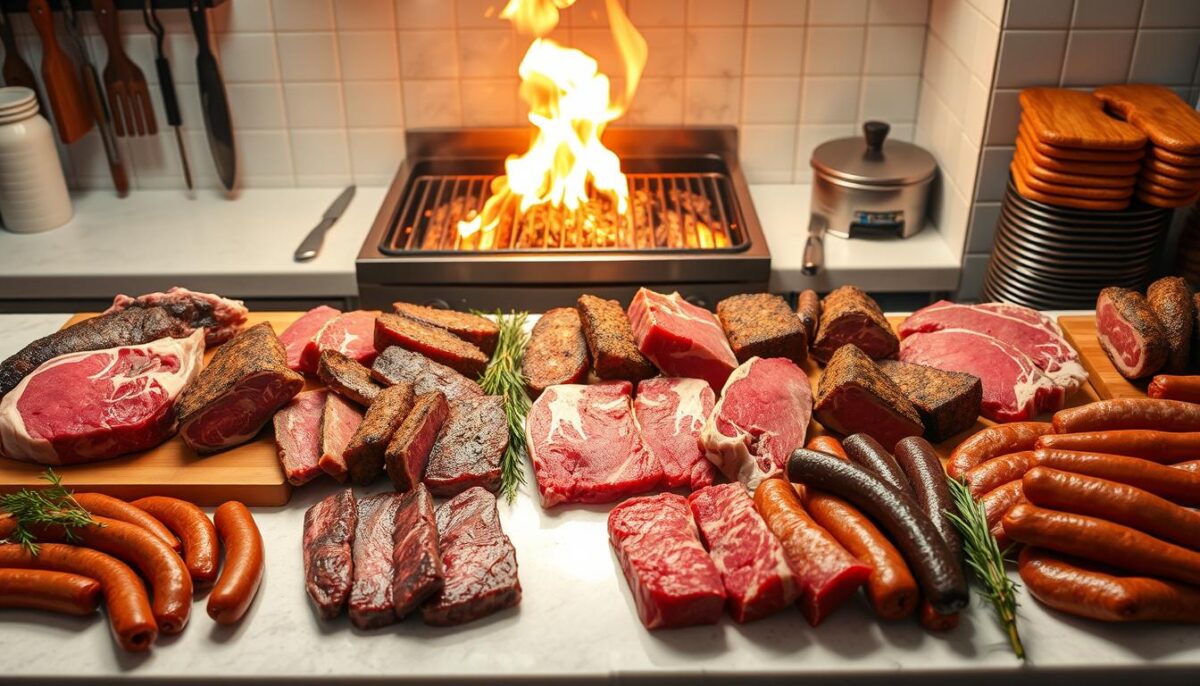
Identifying Signature Cuts Like Short Rib, Flank, and Skirt
Thick short ribs became my gateway to authentic flavors. Their marbling withstands long cooking while staying juicy. Flank steak taught me about grain direction—slice against it, and even tougher cuts melt in your mouth.
| Cut | Key Feature | Grilling Time |
|---|---|---|
| Short Rib | Rich marbling | 2.5 hours |
| Flank | Distinct grain | 45 minutes |
| Skirt | Thin & fibrous | 25 minutes |
Seasoning and Preparing Meat for Maximum Flavor
Early on, I ruined good meat with complicated rubs. Now I use coarse salt, cracked pepper, and a splash of vinegar. The acid tenderizes while enhancing natural flavors.
Three lessons from my kitchen:
- Pat dry surfaces with paper towels before oiling
- Brush vinegar mixtures lightly—too much creates steam
- Let charcoal beds ash over completely for even cooking
Delicate cuts like flank demand attention. I position them over indirect heat first, then finish with a quick sear. This dual-zone approach preserves moisture while creating that crave-worthy crust.
Through trial and error, I discovered simplicity wins. Great meat needs confidence more than complexity. When you honor the cut’s natural qualities, every bite becomes an experience worth savoring.
My Personal Journey: Memories and Lessons Learned from Asado Gatherings
The scent of wood smoke still transports me to my uncle’s backyard, where I first witnessed ribs sizzling beside blood sausage on glowing coals. Friends squeezed around picnic tables, passing bowls of salsa criolla while children chased fireflies. Those nights taught me grilling isn’t solitary—it’s a chorus of shared effort.
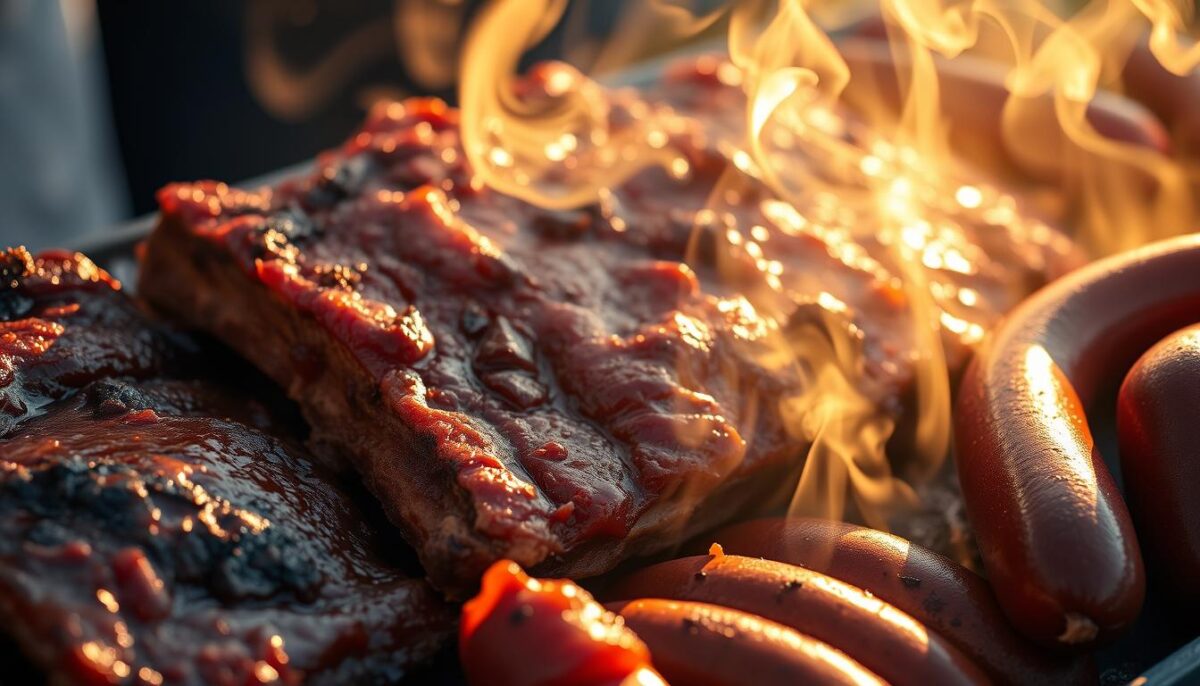
Through local experts, I discovered how cuts meat choices tell stories. A butcher once handed me ribs curved like crescent moons: “These cradle the heat differently—like hugging the fire.” His wisdom changed how I approach every cut. Blood sausage became my gateway to bold flavors, its rich spices balancing simpler beef dishes.
One summer evening, a friend’s homemade salsa criolla transformed everything. The sharp tang of vinegar-cut onions mingled with smoky juices from the grill. Suddenly, our plates weren’t just food—they were conversations between ingredients.
Three truths emerged from years of gatherings:
- Great cuts meat need time, not just heat
- Blood sausage tastes best when shared immediately
- Salsa should crunch louder than the fire’s crackle
Every misstep—overcooked ribs, split sausage casings—taught patience. Now I laugh when flames dance unpredictably. The real magic lies not in perfection, but in the stories exchanged while waiting for coals to mature.
Argentinian BBQ asado guide: Step-by-Step Process to a Traditional Asado
The rhythm of grilling reveals itself in stages—like chapters in a smoky novel. I discovered success comes from respecting each phase, from arranging coals to rotating meats at precise moments.
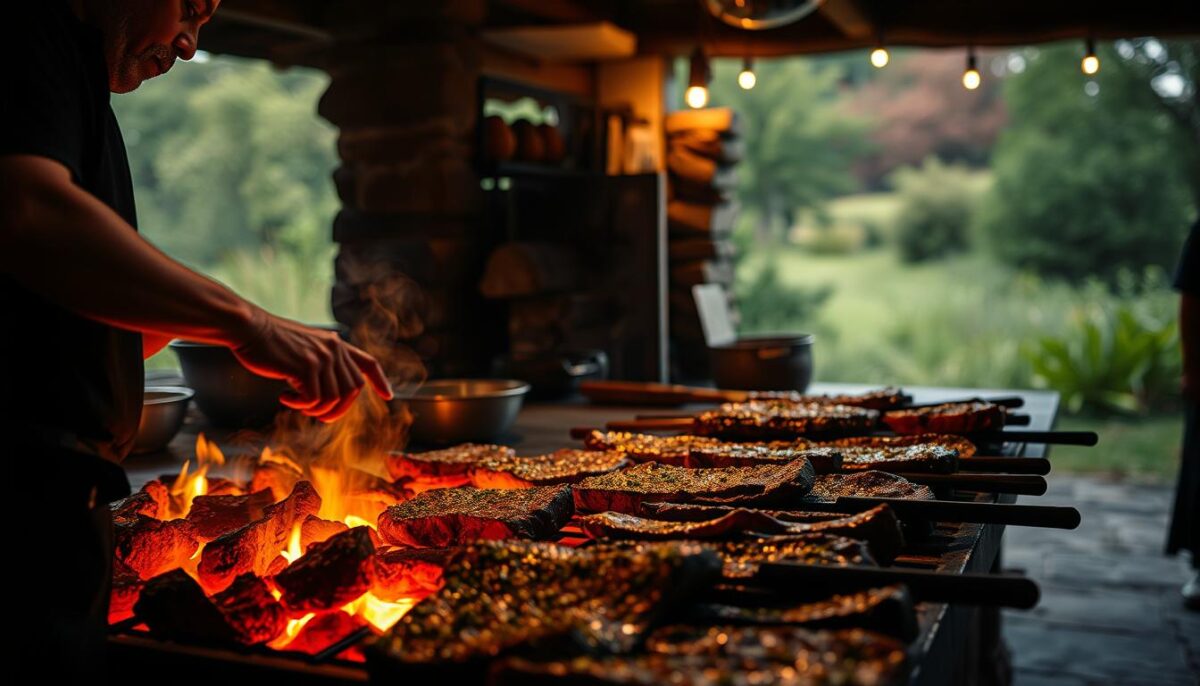
Building Foundations: Fire and Meat Placement
Start by banking embers along one edge of your grill. This creates a gradient of heat zones. Place thick short ribs closest to the glowing coals first—their marbling thrives under slow, intense warmth. Let them sear for 15 minutes before shifting to medium heat.
| Stage | Action | Duration |
|---|---|---|
| Initial | Position short ribs | 15 min |
| Mid-Cook | Add flank steak | 40 min |
| Final | Introduce chorizo | 8 min |
Use a metal rake to nudge embers closer as needed. Thinner cuts join later—flank steak after 40 minutes, delicate sausages in the final moments. This staggered approach prevents overcooking while maximizing flavor development.
The Dance of Timing
Larger cuts teach patience. I rotate short ribs every 20 minutes, basting with their own juices. Meanwhile, prep side dishes that complement without competing—grilled veggies work well during the last hour.
Three timing secrets:
- Check embers every 30 minutes—add wood chunks as needed
- Rest meats 10 minutes before slicing across the grain
- Serve side items warm, not hot, to balance textures
Perfecting this sequence transforms good right cuts into extraordinary meals. The flavor journey—from smoky beginnings to juicy finishes—becomes your edible signature.
Flavor Enhancers: Accompaniments and Sauces That Elevate Your Asado
A drizzle of emerald-green chimichurri once saved my overcooked steak from disaster. That’s when I discovered sides and sauces aren’t just extras—they’re essential partners to smoky meats.
Exploring Salsa Criolla, Chimichurri, and Other Condiments
Coarse salt became my secret weapon. Sprinkled on meats before grilling, it amplifies natural flavors without overpowering. For sides, I keep it fresh—grilled veggies with lemon zest or crusty bread rubbed with garlic.
| Condiment | Key Ingredients | Perfect Pairing |
|---|---|---|
| Chimichurri | Parsley, garlic, vinegar | Grilled flank steak |
| Salsa Criolla | Red onions, vinegar | Blood sausage |
| Grilled Veggies | Zucchini, bell peppers | Short ribs |
Balancing richness matters. Tart salsa criolla cuts through fatty cuts, while herbal chimichurri adds brightness. For drinks, I pour bold reds like Malbec—their tannins stand up to smoky flavors.
What transforms a meal into a family celebration? Sharing bowls of these accompaniments. Pass the chimichurri clockwise, let everyone build their perfect bite. Laughter flows as freely as the wine.
Three rules I live by:
- Season meats generously with salt an hour before grilling
- Serve sides at room temperature to let flavors mingle
- Always have extra napkins—great meals get messy
Through trial and error, I learned that the best drinks match the mood. Iced herbal teas work for lunch gatherings, while evening feasts demand full-bodied reds. But the real magic? Watching family and friends bond over passed plates and shared sauces.
Avoiding Common Pitfalls: Troubleshooting Your Asado Experience
Smoke billowing from sudden flare-ups once left my guests squinting through hazy backyard gatherings. Through these challenges, I learned that graceful recovery separates stressful meals from memorable ones.
Turning Crisis into Opportunity
When flames leap unexpectedly, stay calm. I keep a spray bottle with water nearby—not for dousing, but for misting air above the fire. This cools temperatures without creating bitter smoke. For persistent flare-ups, shift chorizo to cooler zones temporarily.
Thin cuts like skirt steak demand vigilance. Their fibrous texture turns tough in seconds. I use a two-zone setup: sear quickly over high heat, then move to indirect warmth. Probe thermometers help track progress without constant flipping.
| Issue | Quick Fix | Long-Term Solution |
|---|---|---|
| Flare-ups | Mist air above flames | Trim excess fat pre-grill |
| Overcooked skirt | Slice thin for tacos | Use timer alarms |
| Split chorizo | Serve as crumbled topping | Prick casings pre-cook |
Menu adjustments save the day. When my skirt steak overcooked last summer, I transformed it into carne asada tacos with fresh lime. Keep versatile dishes like grilled veggie platters ready—they complement any protein.
Three strategies for marathon sessions:
- Rotate chorizo links every 4 minutes
- Wrap rested meats in foil tents
- Prep backup dishes like bean salads
Remember: Even imperfect meals become legends with the right storytelling. Burnt ends? Call them “smoke-kissed croutons” for your salad. Every challenge hides a chance to innovate.
Conclusion
The true magic of this cooking tradition lies not in perfection, but in the stories shared around glowing coals. Through years of trial and error, I’ve learned that exceptional food emerges when we honor simple truths: let quality cuts shine, balance smoke with bright sauces, and embrace the rhythm of fire.
Every meal becomes a canvas for creativity. Pair robust short ribs with tangy chimichurri, or let sweet onions in salsa criolla elevate humble sausages. Remember—the best cuts need only salt and patience, while vibrant sauces add that final flourish.
Your journey starts where mine did: with curiosity and a single spark. Adjust heat zones to suit your grill, taste fearlessly, and invite friends to gather as the aromas deepen. Great food thrives on personal touches—maybe you’ll discover a new wood blend or a family-favorite side dish.
Now it’s your turn. Light those coals, slice that first cut, and let each meal become a celebration of flavor and connection. The fire’s ready—what stories will you cook up next?
FAQ
What’s the best wood to use for an authentic flavor?
I prefer hardwoods like quebracho or mesquite for their slow burn and rich aroma. Avoid softwoods like pine—they create excess smoke and can overpower the meat’s natural taste.
How do I control heat without a temperature gauge?
Test the heat by holding your hand 5 inches above the grill. If you can keep it there for 3-4 seconds, it’s medium. Adjust the grill height or spread coals to manage intensity. Patience is key!
Which cuts work best for slow cooking?
Short ribs (asado de tira) and flank (vacio) are my go-to choices. They’re marbled, forgiving, and absorb smoke beautifully. Skirt steak (entraña) cooks faster but rewards with bold flavor.
Should I marinate the meat beforehand?
Keep it simple—salt is your friend. I sprinkle coarse salt an hour before grilling. For sausages like chorizo or morcilla, skip marinades to let their spices shine.
What’s the secret to crispy yet juicy sausage?
A> Place chorizo or blood sausage (morcilla) on medium heat first. Rotate often to avoid splitting. A splash of cold water on the grill helps control flare-ups without drying them out.
How do I balance sides without overshadowing the meat?
Salsa criolla (onion, tomato, vinegar) adds brightness. Serve chimichurri on the side for dipping. Grilled provoleta cheese or crusty bread are crowd-pleasers that complement, not compete.
Can I use a regular grill if I don’t have a parrilla?
Absolutely! Prop your grill grate higher and use bricks to stabilize. Focus on arranging coals unevenly for zones—hot for searing, cooler for resting cuts like ribs.
How do I fix meat that’s charring too fast?
Move it to a cooler zone immediately. Brush lightly with salted water or vinegar to cool the surface. Trim burnt edges before serving—it’s all about adapting to the fire’s mood!
